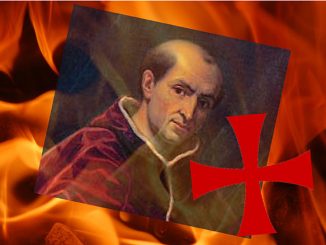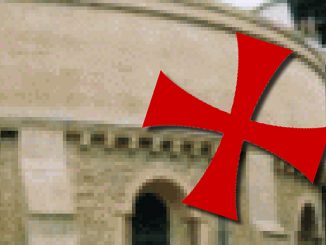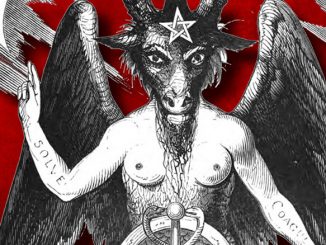
The banner of the Knights Templar was called the Beauseant and, like many pieces of medieval history, its true etymology may have been lost somewhere along the way. An anonymous pilgrim who visited Jerusalem between the twelfth and thirteenth century had the following to say of the Templars, their banner and the Order’s battle techniques:
“The Templars are most excellent soldiers. They wear white mantles with a red cross, and when they go to war a standard of two colors called balzaus is borne before them. They go in silence. Their first attack is the most terrible. In going, they are the first. In returning – the last. They await the orders of their Master. When they think fit to make war and the trumpet has sounded, they sing in chorus the Psalm of David, “Not unto us, O Lord” kneeling on the blood and necks of the enemy, unless they have forced the troops of the enemy to retire altogether, or utterly broken them to pieces. Should any of them for any reason turn his back to the enemy, or come forth alive [from a defeat], or bear arms against the Christians, he is severely punished; the white mantle with the red cross, which is the sign of his knighthood, is taken away with ignominy, he is cast from the society of brethren, and eats his food on the floor without a napkin for the space of one year. If the dogs molest him, he does not dare to drive them away. But at the end of the year, if the Master and brethren think his penance to have been sufficient, they restore him the belt of his former knighthood. These Templars live under a strict religious rule, obeying humbly, having no private property, eating sparingly, dressing meanly, and dwelling in tents.”
The New Knighthood – Malcolm Barber
Other etymological suggestions include piebald, which is perhaps closer to the mark. Piebald means spotted or two color as in a piebald horse or cat. This certainly fits the description of the Beauseant, for it consisted of a black square above a white one.
The late author John J. Robinson claimed that the term Beauseant was Medieval French for “beautiful.” But to a group of knights who were not at all like the vain secular knights of the day, image certainly cannot be the entire interpretation. Robinson also claimed it was a battle cry:
“The word beau is now generally conceived to mean beautiful, but it means much more than that. In medieval French it meant a lofty state, for which translators have offered such terms as “noble,” “glorious,” and even “magnificent” As a battle cry then, “Beau Seant” was a charge to “Be noble” or “Be Glorious.”
Born In Blood – John J. Robinson
 Symbolically, the black section is said to have depicted the sins of the secular world that the Templar knights had chosen to leave, while the second section was white – depicting the purity that the order offered them – a sort of transformation from darkness to light.
Symbolically, the black section is said to have depicted the sins of the secular world that the Templar knights had chosen to leave, while the second section was white – depicting the purity that the order offered them – a sort of transformation from darkness to light.
Despite many depictions of the banner in later day paintings, the battle standard was not such that it drooped down on its pole. Rather, the banner was held in place top and bottom by two poles so that it did not require a breeze to be seen by the Templars and their enemies.
So important was the view of the flying Beauseant that, before a battle, the Marshal would select ten Templars to protect him and the banner. If the Marshal was killed during fighting, the Commander of Knights would take the banner so that it may fly above the battle for all to see.
This created somewhat of a catch twenty -two situation, for as long as the Beauseant flew the Templars must fight on and as long as the Templars fought on, the Beauseant must fly.
The purpose of the banner was to serve as a rallying point for the Templars. One of the Order’s tactics during battle was the heavy horse charge. This often caused the Templars to be separated from one another. As such, the flying Beauseant would allow them to easily regroup in order to continue the attack.
About Us
TemplarHistory.com was started in the fall of 1997 by Stephen Dafoe, a Canadian author who has written several books on the Templars and related subjects.
Read more from our Templar History Archives – Templar History



